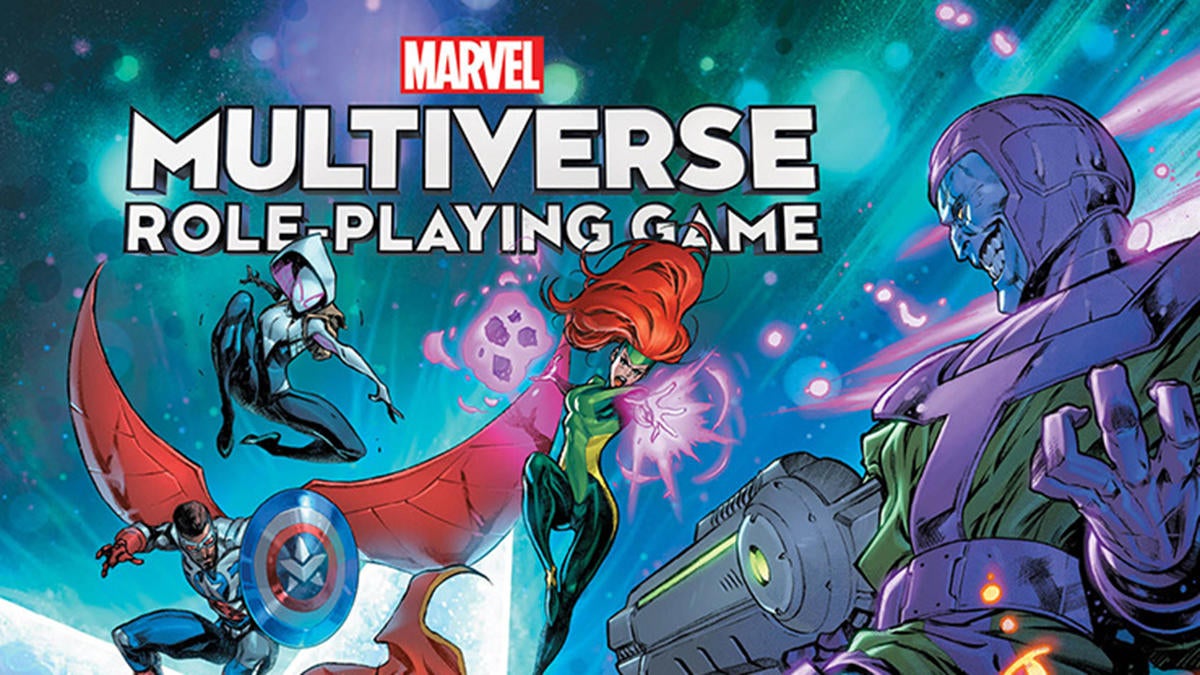It’s hard to believe nearly ten years since the last official Marvel RPG was released. In that time. Marvel has gone from a comic book company to a cultural behemoth. It’s brought home its favorite neighborhood webslinger, made a star out of a talking space raccoon and keeps the water cooler bubbling with weekly streaming shows. This time the company is releasing Marvel Multiverse Roleplaying on its own rather than licensing it out to a dedicated company. But it’s still stacked the deck by bringing in industry veteran Matt Forbeck to design the game. A shortened playtest edition comes out on April 20th but the company sent along a press copy for me to review. How does it stack up to the other ways to make yours Marvel? Let’s play to find out.
The game centers around the d616 system, which features three six sided dice. One of these three dice is the Marvel die, which triggers a special effect when it rolls the Marvel logo that’s in place of the one. For those folks playtesting at home, that means you should have a D6 designated as the Marvel die, preferably one that stands out from the other two. To accomplish goals in the game, players roll these dice and add them to one of their stats, which, of course, spell the word MARVEL: Might, Agility, Resilience, Vigilance, Ego, Logic. In play, it feels a little like Green Ronin’s AGE System mixed with WEG’s Star Wars d6. There’s a little bit of math to see if the roll passes or fails along with a chance of a narrative twist based on if the Marvel die pops off. Critical fails happen if all three dice come up 1, critical successes are if the regular dice roll 6s and the Marvel die rolls a 1 aka 616. On successes, a Marvel roll offers a “yes and” element and on a fail it’s a “no but” consolation.
Combat works on a similar basic principle with gridded distances, to hit rolls and hit points. There is some discussion of theater of the mind combat but the way distances work make this section feel a lot like it was written for people familiar with Fifth Edition combat without being a direct lift. In this draft, the Marvel die only activates knockback but it seems like there would be a lot of room for narrative flexibility.like disarms or add on effects triggered by that 1 out of 6 chance.
The character system is class and level based, though the latter is in-line with how Mutants & Masterminds handles levels. They are a general guide to power, one that can be modified within the stories told within the game. Level 10 seems the default power level here, with 5 being street level or young heroes, 15 being big team names from the X-Men or Avengers and 20 and higher being big cosmic type beings. The assumption here is that heroes remain static, though a discussion on level caps gives folks who want to watch their hero grow provide that option through milestone level ups.
The level system sets how many powers and traits a character has. Many of the traits come from how a character’s class and their origin plug together. Most traits are short, narrative permissions with simple mechanics attached. Usually the trait or the power inflicts a condition, offers a reroll or allows an attack or defense with an unexpected attribute. There’s not a lot of benchmarking here with certain heroes having better versions of powers. That seems all baked into the levels, with the Marvel die showing as the one in a million shot allowing a street level hero to get in an unexpected hit on Thanos, or at least creating an opening for a heavy hitter. It’s clear Marvel is going to sell at least one set of speciality dice for this but I would also like to see cards featuring the various powers and traits that could be dealt out to new players. The single page write-ups look impressive, but keeping in mind what options a character has might be overwhelming for new players.
Powers work like feat trees with options unlocked via previous choices and new levels. This document comes with a dozen power sets plus a general utility pool. These power sets match the characters released as part of the playtest: Peter Parker, Miles Morales, Black Panther, Captain America, Captain Marvel, Groot, Rocket Racoon, Iron Man, Thor, Storm and Wolverine. Characters build powers out of a few groups plus the general utility pool. It may not seem like much, but the relative simplicity of the powers make it pretty easy to hack new ones in the wait for the full book. The Spider Powers web slinging power tree, for example, could just as easily be repurposed as an Ice power tree for an Iceman write up with a minimum of fuss.
The write-ups are for the original 616 universe, but the text discusses how different versions could exist in other worlds. There’s a sense that most groups are going to be some mix of established characters and original creations. It seems easy to build and rebuild characters based on their power levels during specific comic runs or even MCU counterparts.
Marvel Multiverse Role-Playing Game comes down closer to the traditional RPG of its TSR predecessor than the narrative focus of Marvel Heroic Roleplaying. It has a straightforward pass/fail resolution with a small tip of the hat to narrative mechanics. It seems aimed at the larger Marvel or D&D audience rather than previously experienced gamers. How much of this will remain true has yet to be seen. This is a playtest, after all, and the people who plunk down their hard earned time and money can shape the direction of the game for its full release in 2023.







